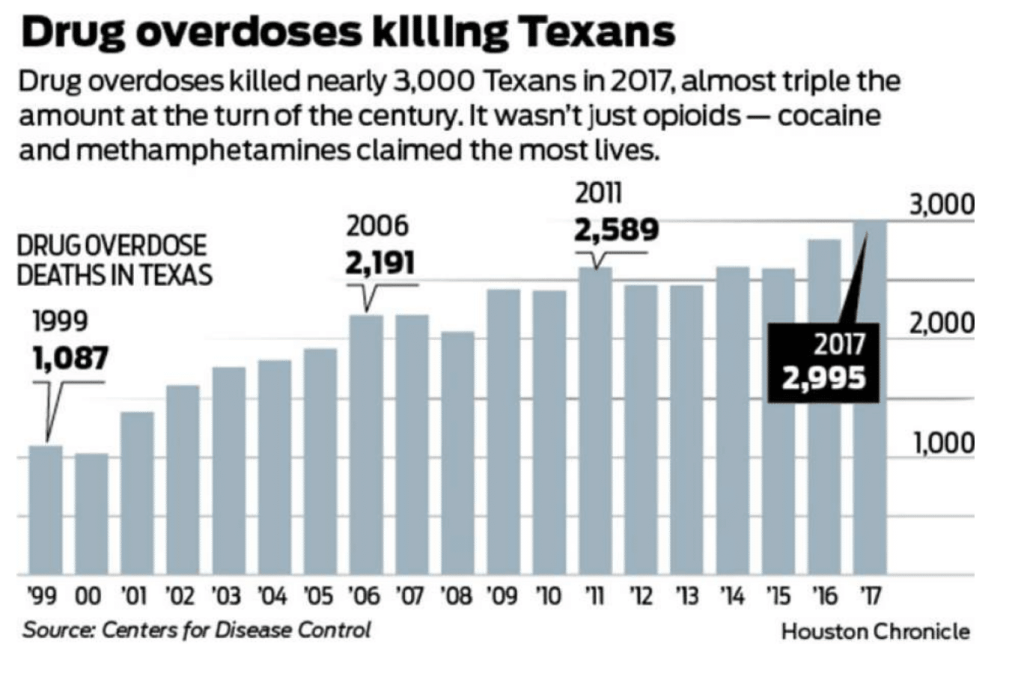

Deaths from drug overdoses in the state of Texas have nearly tripled in the last 18 years. From 1999 to 2017, drug overdose deaths have nearly tripled from 1,087 to 2,979. This increase was across the board for all types of drugs, although methamphetamine and cocaine caused the most overdose deaths in the lone star state. Synthetic opioids like fentanyl are also rising as a cause of an increase of deaths for Texans.
The Center for Disease Control 2017 estimates show that nearly 72,000 Americans died from drug overdoses. While the state of Texas was certainly not accounted as the highest increase across the United States, the alarming trend is that it is increasing at a terrifying rate. States with the highest number of overdose deaths were West Virginia, Washington, Pennsylvania, Ohio and Maryland. These states numbers were heavily driven by prescription, illicit and synthetic opioids. While the nation endures the widely-popularized “opioid epidemic” Texas has yet to see a major increase in overdose deaths from opioids.

This does not count problems with opioids out of the equation for the state of Texas, however. With the increasing availability of fentanyl from the internet and from the porous southern border, Texas officials expect to see an upward trend in opioid overdoses in the years to come. Heroin from the southern border is typically more expensive than methamphetamine, so a lot of drug users typically don’t start with heroin. In Texas there are people who get started on prescription opioids, like Oxycontin or hydrocodone, but the state’s prescription monitoring program (PMP) efforts have made prescription painkiller abuse more difficult to maintain. This system notifies doctors when their patients visit other medical facilities to obtain prescription opioids, or when a Texas resident visits a pharmacy in another state to obtain opioid drugs. These monitoring efforts also have been accompanied by statewide efforts of the Texas Hospital Association to only prescribe short-acting opioids at the lowest dose possible.
Meth has been a major problem in the state of Texas for a very long time. In the late 1990’s and early 2000’s the use of methamphetamine was on a steep increase across the nation. Southwestern states, like Texas were among the first to experience the explosion of the drug’s popularity around this time as the trend continued across all 50 states. Over the course of a decade, the problem seemed to be declining after state and local officials cracked down on the manufacture and supply of pseudoephedrine (the principal ingredient in methamphetamine). Pseudoephedrine is the common cold and allergy decongestant that was available at every local corner drugstore.
When local officials cracked down on the manufacture of meth in clandestine labs (like those popularized in the hit show: Breaking Bad), the Mexican drug cartels stepped-up their supply efforts. Today, meth is coming across rural portions of the southern border, making Texas the first stop on the way to the rest of the continental United States. Therefore, the efforts by state lawmakers to reduce the manufacture of meth in Texas has done very little to disrupt the supply of the drug in the state. As there is a lot of money to be made on the black market for illicit drugs, the Mexican drug cartels will seemingly always step up production south of the border to meet the demand of American consumers. To illustrate this, the Drug Enforcement Agency released data on testing of confiscated samples of meth from 2013:
“Only 1 percent of the samples from across the United States examined in the DEA’s MPP were produced from the pseudoephedrine method. Ninety-five percent was produced from the phenyl-2-propanone (P2P) method, which is used in Mexico, where it is legal.” –Substance Abuse Trends in Texas, 2014. Dr. Jane C. Maxwell, Ph.D.
Methamphetamines took the lives of 577 Texans in 2016, a steep increase since 1999 where only 15 people died from a meth overdose. Increasingly, the drug has become popular with children and young adults, which points to a further increase in meth overdoses if the problem continues to grow.

Cocaine overdoses killed the most Texans in 2016 according to CDC data. While there had been a 17% decrease in cocaine seizures on the US-Mexico border from 2010-2015, the drug has been increasing in popularity in recent years. Many people have moved away from smoking crack cocaine and returned to snorting the white powdered cocaine as there is a seemingly lower stigma for inhaling powdered cocaine. Popular culture seems to be more accepting of cocaine use as many songs on the radio, television shows and movies have glamorized its use in recent years.
Though seizures on the border have reduced most likely due to internal conflicts in the Mexican drug cartels, cocaine production is up in Colombia and the drug is somehow finding its way into American communities. In fact, in 2018, $18 million dollars worth of cocaine was found in boxes of bananas that were being donated to a Texas state prison. Many attribute cocaine’s increase in abuse to an increase in supply from Colombia. Recently, the nation of Colombia ended an aerial crop spraying program because the herbicide intended to kill cocoa plants was poisoning the local ecosystem. Authorities believe this has encouraged cartels to plant more of the cocoa plant, thus increasing supply.
Stopping the supply of drugs from the southern border should be considered a worthwhile effort and it will definitely continue. At some point however, the state of Texas, and the entire nation should constantly monitor our efforts to reduce substance abuse, aimed at reducing drug overdose deaths. Are our efforts really working? Should we switch our focus from a criminal justice approach to drug abuse or should we start viewing addiction as a public health crisis?
Regardless of how you view substance abuse and addiction, there are people in Texas who need help. Every day offers the potential for someone to turn their life around by choosing to quit drugs. We employ a social model of addiction recovery to help you succeed in sobriety, long after you leave the drug rehab program. If you are struggling with addiction, contact us at More Than Rehab today, we can help you overcome addiction and begin a new, healthy lifestyle.

